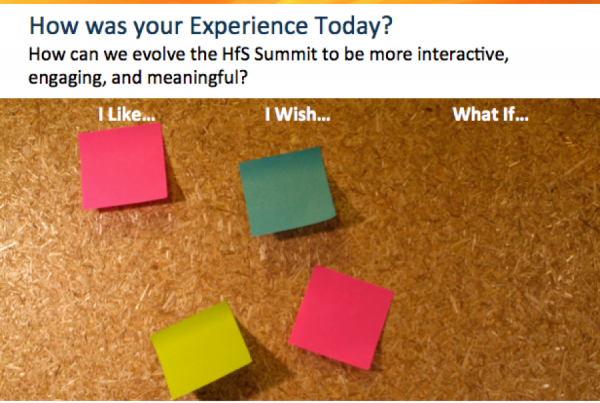The time a person has the most interest and insight into an activity is when they’re doing it. Did you just finish helping someone or facilitating a meeting and wish you could quickly get feedback on what the person or attendee is thinking?
What did they like? What did they wish you did differently, more of, eliminate, change, or add? What bright ideas do they have that you just wouldn’t think of yourself? Sometimes people’s quick thoughts and reactions can be the most valuable feedback. In the moment, you are also likely to tap into the “gut reaction” and how they are feeling.
To get feedback in the moment, we’ve been using a design thinking exercise in our HfS Summits. The exercise we use is based on the simple and useful questions in the Stanford d.School toolbox (link).

Source: Tools from Stanford d.school
Here’s how we use it: We put pens and sticky pads on all tables, plus a flip chart or whiteboard somewhere in the room. (When you start to do more design thinking you’ll realize that sticky notes and design thinking go together like water and ducks.) Then towards the end of the day we do this exercise to get feedback to confirm, challenge, and share on our objective.
Our question: How can we evolve the HfS Summit to be more interactive, engaging, and meaningful? In the next 5 minutes, write down what comes to mind to finish the following:
- I liked…
- I wish…
- What if…
Then we encourage attendees to get up and put their sticky notes on the flip chart pad under the phrase that starts the same way. Soon, we have people up and milling around, colorful walls, and energy flowing.
Almost everyone writes something – either because they have something to say or perhaps because they feel peer pressure to perform. By asking these questions, we get specific feedback on sessions, logistics, and content – the good, the bad, and the ugly. The insights, ideas, and feedback also show us themes among what on the minds and in the interests of our attendees, and we see where there are really strong feelings.
This feedback is an addition to the formal surveys. The design thinking exercise engages attendees in a way that the formal survey doesn’t. For example, any event organizer will tell you their frustration with attendees who leave the “what else would you like to see?” or “anything else you want to tell us?” sections blank. But in the moment, when everyone is still engaged in the event, they easily share ideas and commentary.
I often get asked how to get started with Design Thinking. Although the tendency is to attach design thinking to a workshop – and there are proven benefits to taking a day or more out of your regular schedule to do this – you can also incorporate design thinking principles and activities into the way you work on a regular basis. This is one example of an activity that is so easy and simple, that you can immediately start to use it in meetings, in conversations, with sticky notes or even electronic questions in text messaging.
Bottom Line: If you want to understand someone’s experience and get feedback that you can wrap into a future interaction, meeting, activity, or event, ask: What did you like? What do you wish for? What if?
Posted in : Design Thinking






